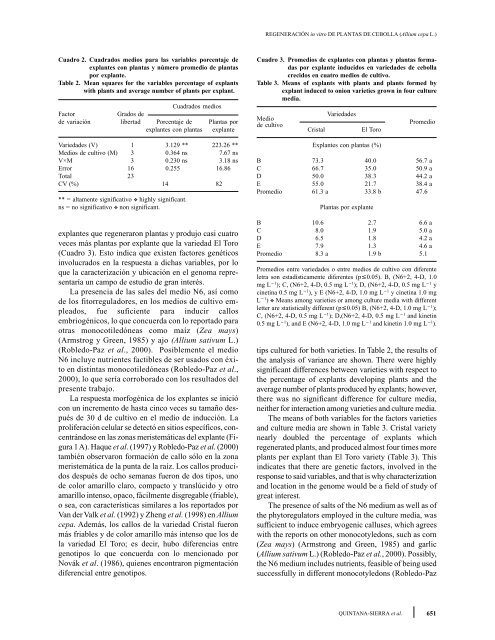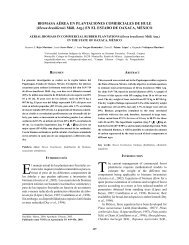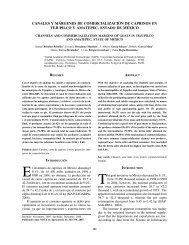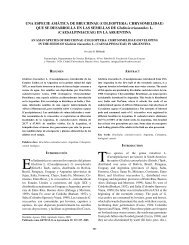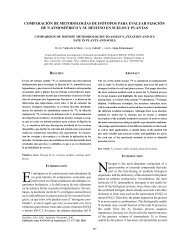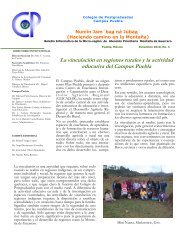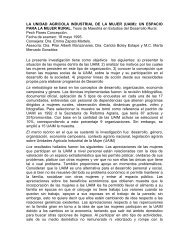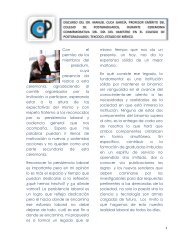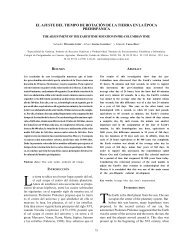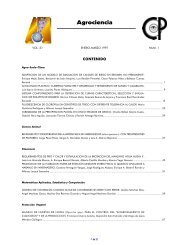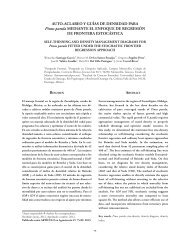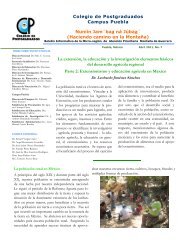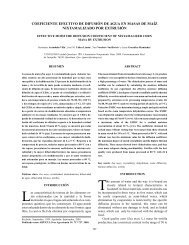04-161 (Regeneración in vitro) - Colegio de Postgraduados
04-161 (Regeneración in vitro) - Colegio de Postgraduados
04-161 (Regeneración in vitro) - Colegio de Postgraduados
Create successful ePaper yourself
Turn your PDF publications into a flip-book with our unique Google optimized e-Paper software.
Cuadro 2. Cuadrados medios para las variables porcentaje <strong>de</strong><br />
explantes con plantas y número promedio <strong>de</strong> plantas<br />
por explante.<br />
Table 2. Mean squares for the variables percentage of explants<br />
with plants and average number of plants per explant.<br />
Cuadrados medios<br />
Factor Grados <strong>de</strong><br />
<strong>de</strong> variación libertad Porcentaje <strong>de</strong> Plantas por<br />
explantes con plantas explante<br />
Varieda<strong>de</strong>s (V) 1 3.129 ** 223.26 **<br />
Medios <strong>de</strong> cultivo (M) 3 0.364 ns 7.67 ns<br />
V×M 3 0.230 ns 3.18 ns<br />
Error 16 0.255 16.86<br />
Total 23<br />
CV (%) 14 82<br />
** = altamente significativo ❖ highly significant.<br />
ns = no significativo ❖ non significant.<br />
explantes que regeneraron plantas y produjo casi cuatro<br />
veces más plantas por explante que la variedad El Toro<br />
(Cuadro 3). Esto <strong>in</strong>dica que existen factores genéticos<br />
<strong>in</strong>volucrados en la respuesta a dichas variables, por lo<br />
que la caracterización y ubicación en el genoma representaría<br />
un campo <strong>de</strong> estudio <strong>de</strong> gran <strong>in</strong>terés.<br />
La presencia <strong>de</strong> las sales <strong>de</strong>l medio N6, así como<br />
<strong>de</strong> los fitorreguladores, en los medios <strong>de</strong> cultivo empleados,<br />
fue suficiente para <strong>in</strong>ducir callos<br />
embriogénicos, lo que concuerda con lo reportado para<br />
otras monocotiledóneas como maíz (Zea mays)<br />
(Armstrog y Green, 1985) y ajo (Allium sativum L.)<br />
(Robledo-Paz et al., 2000). Posiblemente el medio<br />
N6 <strong>in</strong>cluye nutrientes factibles <strong>de</strong> ser usados con éxito<br />
en dist<strong>in</strong>tas monocotiledóneas (Robledo-Paz et al.,<br />
2000), lo que sería corroborado con los resultados <strong>de</strong>l<br />
presente trabajo.<br />
La respuesta morfogénica <strong>de</strong> los explantes se <strong>in</strong>ició<br />
con un <strong>in</strong>cremento <strong>de</strong> hasta c<strong>in</strong>co veces su tamaño <strong>de</strong>spués<br />
<strong>de</strong> 30 d <strong>de</strong> cultivo en el medio <strong>de</strong> <strong>in</strong>ducción. La<br />
proliferación celular se <strong>de</strong>tectó en sitios específicos, concentrándose<br />
en las zonas meristemáticas <strong>de</strong>l explante (Figura<br />
1 A). Haque et al. (1997) y Robledo-Paz et al. (2000)<br />
también observaron formación <strong>de</strong> callo sólo en la zona<br />
meristemática <strong>de</strong> la punta <strong>de</strong> la raíz. Los callos producidos<br />
<strong>de</strong>spués <strong>de</strong> ocho semanas fueron <strong>de</strong> dos tipos, uno<br />
<strong>de</strong> color amarillo claro, compacto y translúcido y otro<br />
amarillo <strong>in</strong>tenso, opaco, fácilmente disgregable (friable),<br />
o sea, con características similares a los reportados por<br />
Van <strong>de</strong>r Valk et al. (1992) y Zheng et al. (1998) en Allium<br />
cepa. A<strong>de</strong>más, los callos <strong>de</strong> la variedad Cristal fueron<br />
más friables y <strong>de</strong> color amarillo más <strong>in</strong>tenso que los <strong>de</strong><br />
la variedad El Toro; es <strong>de</strong>cir, hubo diferencias entre<br />
genotipos lo que concuerda con lo mencionado por<br />
Novák et al. (1986), quienes encontraron pigmentación<br />
diferencial entre genotipos.<br />
REGENERACIÓN <strong>in</strong> <strong>vitro</strong> DE PLANTAS DE CEBOLLA (Allium cepa L.)<br />
Cuadro 3. Promedios <strong>de</strong> explantes con plantas y plantas formadas<br />
por explante <strong>in</strong>ducidos en varieda<strong>de</strong>s <strong>de</strong> cebolla<br />
crecidos en cuatro medios <strong>de</strong> cultivo.<br />
Table 3. Means of explants with plants and plants formed by<br />
explant <strong>in</strong>duced to onion varieties grown <strong>in</strong> four culture<br />
media.<br />
Medio<br />
<strong>de</strong> cultivo<br />
Varieda<strong>de</strong>s<br />
Cristal El Toro<br />
Explantes con plantas (%)<br />
tips cultured for both varieties. In Table 2, the results of<br />
the analysis of variance are shown. There were highly<br />
significant differences between varieties with respect to<br />
the percentage of explants <strong>de</strong>velop<strong>in</strong>g plants and the<br />
average number of plants produced by explants; however,<br />
there was no significant difference for culture media,<br />
neither for <strong>in</strong>teraction among varieties and culture media.<br />
The means of both variables for the factors varieties<br />
and culture media are shown <strong>in</strong> Table 3. Cristal variety<br />
nearly doubled the percentage of explants which<br />
regenerated plants, and produced almost four times more<br />
plants per explant than El Toro variety (Table 3). This<br />
<strong>in</strong>dicates that there are genetic factors, <strong>in</strong>volved <strong>in</strong> the<br />
response to said variables, and that is why characterization<br />
and location <strong>in</strong> the genome would be a field of study of<br />
great <strong>in</strong>terest.<br />
The presence of salts of the N6 medium as well as of<br />
the phytoregulators employed <strong>in</strong> the culture media, was<br />
sufficient to <strong>in</strong>duce embryogenic calluses, which agrees<br />
with the reports on other monocotyledons, such as corn<br />
(Zea mays) (Armstrong and Green, 1985) and garlic<br />
(Allium sativum L.) (Robledo-Paz et al., 2000). Possibly,<br />
the N6 medium <strong>in</strong>clu<strong>de</strong>s nutrients, feasible of be<strong>in</strong>g used<br />
successfully <strong>in</strong> different monocotyledons (Robledo-Paz<br />
QUINTANA-SIERRA et al.<br />
Promedio<br />
B 73.3 40.0 56.7 a<br />
C 66.7 35.0 50.9 a<br />
D 50.0 38.3 44.2 a<br />
E 55.0 21.7 38.4 a<br />
Promedio 61.3 a 33.8 b 47.6<br />
Plantas por explante<br />
B 10.6 2.7 6.6 a<br />
C 8.0 1.9 5.0 a<br />
D 6.5 1.8 4.2 a<br />
E 7.9 1.3 4.6 a<br />
Promedio 8.3 a 1.9 b 5.1<br />
Promedios entre varieda<strong>de</strong>s o entre medios <strong>de</strong> cultivo con diferente<br />
letra son estadísticamente diferentes (p≤0.05). B, (N6+2, 4-D, 1.0<br />
mg L −1 ); C, (N6+2, 4-D, 0.5 mg L −1 ); D, (N6+2, 4-D, 0.5 mg L −1 y<br />
c<strong>in</strong>et<strong>in</strong>a 0.5 mg L −1 ), y E (N6+2, 4-D, 1.0 mg L −1 y c<strong>in</strong>et<strong>in</strong>a 1.0 mg<br />
L −1 ) ❖ Means among varieties or among culture media with different<br />
letter are statistically different (p≤0.05) B, (N6+2, 4-D, 1.0 mg L −1 );<br />
C, (N6+2, 4-D, 0.5 mg L −1 ); D,(N6+2, 4-D, 0.5 mg L −1 and k<strong>in</strong>et<strong>in</strong><br />
0.5 mg L −1 ), and E (N6+2, 4-D, 1.0 mg L −1 and k<strong>in</strong>et<strong>in</strong> 1.0 mg L −1 ).<br />
651


